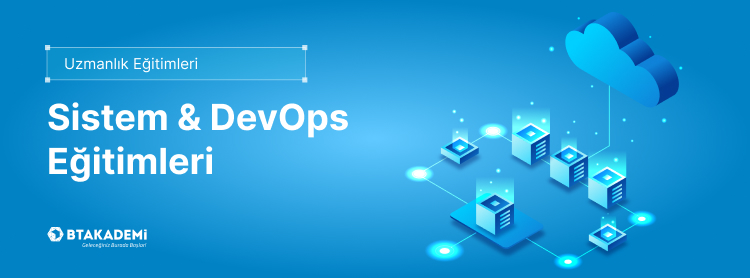
Ön Koşul
Eğitim Hakkında
At the end of the training, attendee was expected to answer questions below by themselves.
-What are fundamentals of Kubernetes?
-What are the security aspects of Kubernetes?
-How to design Kubernetes Cluster from scratch?
-What are the network aspects of Kubernetes?
Sertifika:
Eğitimlerimize %80 oranında katılım gösterilmesi ve eğitim müfredatına göre uygulanacak sınav/projelerin başarıyla tamamlanması durumunda, eğitimin sonunda dijital ve QR kod destekli “BT Akademi Başarı Sertifikası” verilmektedir
Eğitim İçeriği
▪ Overview of Container Orchestration
▪ Introduction to Kubernetes
▪ Installation Options for Kubernetes
▪ Using Managed Kubernetes Service from CSP
▪ Installing & Configuring kubectl for Linux
▪ Document - Installation of Kubectl
▪ Configuring Kubernetes in Minikube in Windows
▪ Document - Minikube Installation Commands
▪ Configuring Kubernetes in Minikube in Linux
▪ Document - Minikube Installation Commands
▪ Understanding PODS
▪ Understanding Kubernetes Objects
▪ Overview of Kubernetes Cluster Architecture
▪ K8S Components – ETCD
▪ K8S Components – kube-apiserver
▪ Introduction to API
▪ Kubernetes API Primitives
▪ Creating First POD Configuration in YAML
▪ Document - API Resources for writing YAML files
▪ Working with Multi-Container Pods
▪ Setting Environment Variables for Windows
▪ K8S Components – kube-scheduler
▪ Document - Note on CMD vs Entrypoint
▪ Revising Dockerfile – CMD vs ENTRYPOINT
▪ Understanding Commands and Arguments in Kubernetes
▪ CLI Documentation of K8s Resources
▪ Revising DockerFile - EXPOSE Instruction
▪ Application Lifecycle Management
▪ Introduction to Labels and Selectors
▪ Implementing Labels and Selectors
▪ Overview of ReplicaSets
▪ Creating our first ReplicaSet
▪ Introduction to Deployments
▪ Creating our first deployment
▪ Rolling Back Deployments
▪ Understanding Liveness Probe
▪ Understanding Readiness Probe
▪ Overview of Docker Restart Policy
▪ Overview of Batch Jobs
▪ Creating first Job in Kubernetes
▪ CronJobs
▪ Overview of Service
▪ Creating our first Service and Endpoint
▪ Service Type: ClusterIP
▪ Using Selectors for Service Endpoints
▪ Service Type: NodePort
▪ Service Type: Load Balancer
▪ Overview of Ingress
▪ Understanding Ingress Resource and Ingress Controllers
▪ Overview of Helm
▪ Configuring Helm and Tiller
▪ Deploying our first Helm Chart
▪ Named Based Virtual Hosting (Ingress)
▪ Deploying Nginx Ingress Controller
▪ Configuring Default BackEnd for Ingress
▪ Kubernetes Namespace
▪ Understanding kube-proxy
▪ Understanding DaemonSets
▪ Overview of NodeSelector
▪ Understanding Node Affinity
▪ Pod Affinity and Pod Anti-Affinity
▪ Resource Limits
▪ Scheduling Pods without a Scheduler
▪ Taints and Tolerations
▪ Components of Taints and Tolerations
▪ Understanding Authentication
▪ Introduction to Asymmetric Key Encryption
▪ Understanding SSL/TLS
▪ Creating TLS Certificate for Authentication
▪ Understanding Authorization
▪ API Groups, Resources and Verbs
▪ Access Control based on Namespace
▪ ClusterRole and ClusterRoleBinding
▪ Kubernetes Secrets
▪ Mounting Secrets Inside Pods
▪ Network Security Policies
▪ Linux Capabilities with Docker Containers
▪ Overview of Privileged Containers
▪ Running Privileged Containers in Kubernetes
▪ Understanding Kubeconfig
▪ Creating Kubeconfig from Scratch
▪ Overview of Docker Volumes
▪ Creating Volumes in Kubernetes
▪ PersistentVolume and PersistentVolumeClaim
▪ Static vs Dynamic Provisioning of PV
▪ ConfigMaps
▪ Security Contexts
▪ Configuring Cluster with kubeadm
▪ Kubernetes Cluster from Scratch
▪ Provisioning Release Binaries
▪ Configuring the Certificate Authority
▪ Installing and Configuring ETCD
▪ Configuring kube-api server
▪ Configuring Controller Manager
▪ Configuring Scheduler
▪ Validating Cluster Component Status
▪ Worker Node Configurations
Neden Bu Eğitimi Almalısınız ?
.
Önemli Notlar
Program ücretlerine KDV dahil değildir.

